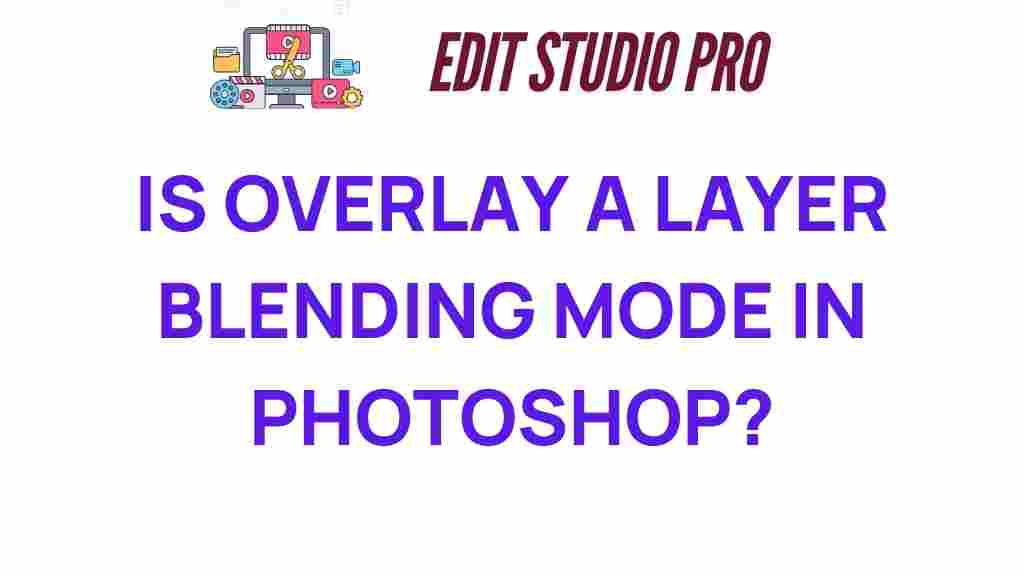Unlocking the Secrets of Overlay: A Layer Blending Mode in Photoshop
When it comes to digital art, photo editing, and graphic design, understanding the various blending modes in Photoshop can significantly enhance your creative potential. One of the most powerful and versatile blending modes is the Overlay mode. This article will explore the intricacies of the Overlay blending mode, how it affects layers, and how you can apply it to create stunning visual effects in your projects.
What is the Overlay Blending Mode?
The Overlay blending mode combines the effects of the Multiply and Screen blending modes. It darkens the colors of the layers below when the blend color is darker than 50% gray and lightens them when the blend color is lighter than 50% gray. This dual effect creates a striking contrast and enhances the overall dynamic of your artwork.
How to Use the Overlay Blending Mode in Photoshop
Using the Overlay blending mode is straightforward, but applying it effectively requires practice. Follow these steps to get started:
- Open Your Project: Launch Photoshop and open the image or project you want to edit.
- Create a New Layer: Click on the ‘New Layer’ icon in the Layers panel or go to Layer > New > Layer… to create a new layer.
- Select the New Layer: Ensure your new layer is selected in the Layers panel.
- Choose Your Color: Select the Brush Tool and choose a color you want to use for the overlay effect.
- Paint on the New Layer: Use the Brush Tool to paint over the areas where you want to apply the Overlay effect. Be creative!
- Set the Blending Mode: In the Layers panel, click on the dropdown menu that says “Normal” and select “Overlay.”
- Adjust Opacity: If the effect is too strong, you can adjust the layer’s opacity to achieve the desired intensity.
Creative Applications of the Overlay Blending Mode
The Overlay blending mode can be utilized in various ways to enhance your digital art and photo editing projects:
- Enhancing Contrast: Use the Overlay mode to increase contrast in images, making them more vibrant.
- Color Grading: Apply different colors with the Overlay mode to create a unique mood or atmosphere in your artwork.
- Text Effects: Create standout text by placing it on a new layer and applying the Overlay blending mode.
- Layering Textures: Overlay textures onto images to add depth and interest without overwhelming the original image.
Understanding the Mechanics of Overlay
To master the Overlay blending mode, it’s essential to understand how it works under the hood. Here’s a brief overview:
- Dark Colors: When a color on the overlay layer is darker than 50% gray, it darkens the colors underneath, enhancing shadow areas.
- Light Colors: Conversely, when the color is lighter than 50% gray, it lightens the colors below, highlighting bright areas.
- Neutral Gray: A 50% gray color will not affect the colors of the layers below it.
This behavior allows artists and designers to manipulate their images creatively, adding depth, dimension, and complexity to their work.
Step-by-Step Example: Creating a Dramatic Photo Effect with Overlay
Let’s walk through a practical example of using the Overlay blending mode to create a dramatic effect on a photograph.
- Select Your Image: Open a photo that you want to enhance.
- Create a New Layer: As mentioned earlier, create a new layer.
- Choose a Brush: Set your brush tool to a soft round brush and choose a dark color (like dark blue or black).
- Paint Shadows: Gently paint over the shadow areas of your image on the new layer.
- Change Blending Mode: Set the new layer to Overlay in the Layers panel.
- Adjust Opacity: If necessary, reduce the opacity to soften the effect.
- Enhance Highlights: Repeat the process with a lighter color to brighten the highlight areas.
- Final Adjustments: Make any additional adjustments to color, contrast, or saturation as needed.
By following these steps, you can transform an ordinary photograph into a visually striking piece of art using the Overlay blending mode.
Troubleshooting Common Issues with Overlay
While the Overlay blending mode is powerful, you may encounter some challenges. Here are some common issues and how to troubleshoot them:
- Effect Too Intense: If the effect appears too strong, try reducing the layer’s opacity or using a softer brush with lower flow for painting.
- Colors Not Blending Well: Ensure that the colors you are using on the Overlay layer are carefully chosen. Sometimes, using colors that are too saturated can result in harsh effects.
- Loss of Detail: If details are lost in shadows or highlights, consider adding an adjustment layer, such as Curves or Levels, to refine the contrast further.
- Not Seeing Changes: Make sure the Overlay blending mode is correctly selected and that you are painting on the right layer.
By being aware of these potential issues, you can better navigate the complexities of using the Overlay blending mode in your projects.
Conclusion
The Overlay blending mode in Photoshop is an essential tool for any graphic design, digital art, or photo editing enthusiast. Its ability to enhance contrast and blend colors creatively makes it invaluable for achieving stunning visual effects. By mastering the use of layers and experimenting with the Overlay mode, you can unlock new levels of creativity in your work.
Whether you’re applying it to a photo, a design project, or an illustration, the Overlay blending mode offers endless possibilities. So, don’t hesitate to dive in and experiment with this powerful feature in your next Photoshop project. For more tips on using Photoshop, check out our comprehensive guide on blending modes.
For further reading and resources, visit Adobe’s official website, where you can find tutorials, forums, and support for all your Photoshop needs.
This article is in the category Photo Editing and created by EditStudioPro Team

4 thoughts on “Unlocking the Secrets of Overlay: A Layer Blending Mode in Photoshop”